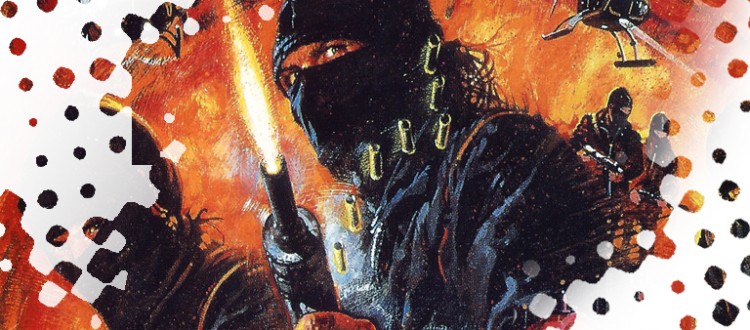In the second part of Mike Leeder’s look at The Ninja Mission, he examines the film’s journey to the screen and the career of its director…
 As often happens, the director of The Ninja Mission, Matts Helge, (born Mats-Helge Olsen in 1953) – while being probably one of if not the most prolific independent Swedish Directors ever with almost 100 movies to his credit – is probably better known outside of his native home, where he and his movies are sadly regarded as an oddity and not high art.
As often happens, the director of The Ninja Mission, Matts Helge, (born Mats-Helge Olsen in 1953) – while being probably one of if not the most prolific independent Swedish Directors ever with almost 100 movies to his credit – is probably better known outside of his native home, where he and his movies are sadly regarded as an oddity and not high art.
Helge made movies for the masses, he made Swedish ‘lingonberry‘ Westerns and all manner of action films that did good business on video and the grindhouse cinema circuit around the world, including Blood Tracks, Eagle Island, Animal Protector, Fatal Secret, The Russian Terminator, a short lived TV series Nordexpressen, and of course The Ninja Mission!
I’m not the only person who’s a fan of Mats Helge and The Ninja Mission, but thanks to Melker Becker and Mattias Lindeblad, finally we get to learn more of his story and about the making of the movie, with their very entertaining documentary The Director Who Disappeared: The Story of the Ninja Mission.
He was Sweden’s Biggest Director! He inspired, taught and worled with the biggest names in the business. He also made the weirdest Swedish movie ever. And despite a remarkable breakthrough, you have probably never seen the masterpiece or heard of the Director!
Hi, Mats Helge… if you ever read this… We saw your film in junior high. It changed our lives. Please contact us. We would love to include you in this documentary. He proved that nothing is impossible. Today, he’s a legend and his movies have reach cult status the world over. But it doesn’t seem like anyone can say exactly how it all happened. The only one who really knows is missing without a trace.
Thus begins the documentary which attempts to pull back the curtain and reveal the true story of Mats Helge and the making of the Ninja Mission as well as his other work, its a very entertaining journey they take us on as they chase leads and get various stories telling them he’s in Denmark, he’s in Canada and from someone else that hes dead!
They uncover a certain amount about Helge: he graduated from school with poor grades in very subject, and that people thought he was illiterate and slow, and that perhaps if he was lucky he might be able to get a job sweeping the floor in a factory. But we also learn that Helge was indeed stubborn and had a dream of making movies and wasn’t going to let anyone tell him or try to stop him from doing just that. And assembling a small team of inexperienced but like minded friends, he sets out to make a Swedish Western (known as Lingonberry Westerns as a Swedish take on Spaghetti Westerns!) called Dead Man’s Trail. They somehow manage to assemble a cast of ‘name’ Swedish actors, get the movie company that makes some of their favourite westerns, lend them costumes and at 20 years old they make a movie that while not breaking the box office, does turn a few heads.
The team of Beker and Lindebla manage, through an associate, to make provisional contact with Helge who has heard of their interest in him and their plans to make a documentary about him… and while they wait for word back from the man himself, they uncover the next chapter in the story. A big-name Swedish actor contacted Helge after Dead Man’s Trail, offering him the chance to produce his passion project which the actor Per Oscasson will not only direct, but act in four roles in the project. A combination of costume drama / comedy about three invading kings and a story about how to breed a superman, Sweden for the Swedes will be the biggest , most expensive and possibly most infamous movie ever made in Sweden. No clips are shown from the movie, as rights issues continue to this day but we learn that everything that could possibly go wrong, did go wrong: from a director in over his head (who would make insane requests at night for the following days shoot) and Helge would do what was asked of him, to an ever increasing budget which Helge is responsible for. The movie, of course, tanked at the box office… and leaves Helge taking the blame. The case goes to court, and while everyone else seems to be cleared, Helge takes the blame and is sent to prison.
Released from prison, with the debt still hanging over his head, Helge surprisingly continues with his desire to make movies – his release from prison coinciding with the huge boom in the industry caused by the sudden popularity of the home video recorder. While now we’re used to being able to watch a Bruce Lee movie, a James Bond movie, a Star Wars movie etc at the click of a button, in the early 80s this was revolutionary for the whole world. Films now have a huge after-life, the theatrical release is no longer the only avenue to explore. One genre in particular captures the attention of Mats Helgem the Ninja! The black clad shadow warrior, and while most people make do with watvhing the movies themselves, or perhaps having a go at making their own throwing stars (Hands up who else got into trouble for making them in metalwork class? Leeder? You boy, put them down now!)
A chance encounter introduces Helge to Sweden’s only Ninja, Bo F Munthe, who has an idea of his own for makng a Ninja movie, in Sweden! Munthe heads to Stockholm to meet with Distributor Charles Aperia who had just released a couple of Ninja movies to great success on video, sitting in his office that fateful day when Munthe arrives is Helge and the three men join forces and come up with the concept that will become The Ninja Mission. A showdown between the CIA and the KGB with Ninjas in the middle of the Cold War!
Helge gets introduced to some Polish actors by a friend, who assures him they are ‘half as expensive but twice as good as Swedes!”, who can refuse an offer like that. But at that time to get the Polish actors and much of the crew, they needed permission from the Polish Communist authorities, so a different script is given to them that doesnt talk about Ninjas blowing up Russians and fleeing to the West! Approval is given and with an incomplete script, shooting takes place over a year with the script frequently being used as a rough guideline and much of the film being improvised. The movie is completed and opens in Sweden to complete disdain, with the concept and the filmmakers themelves being derided by their compatriots. That is until something completely unexpected happens, New Line Cinema picks up the US distribution rights and releases the film theatrically, part of the selling point being a mis-timed special effects mistake: one of the Ninjas was supposed to decapitate an enemy but instead of hitting the neck, he sliced through the head and that simple mistake has audiences overseas cheering. The movie ends up playing in over 50 cinemas just in New York and starts making serious money. Helge is now succeeding where so many directors have failed, he has a hit film in the States!
 Helge is given a green light to create his own down and dirty low-tech film factory: to make cheap and action packed movies for the international market. Behind the scenes footage from a Swedish TV programme shows Helge almost like a kindergarten teacher teaching people his homegrown rough and ready way of movie making, but the reporter seems intent on belittling Helge, his team and his work throughout. Not helped by some of his crew, including one girl hired as a writer for Helge who says “ I like more serious movies‘ So you think this is a shitty movie, asks the reporter? Its painful to watch, but by the time the show airs, Helge’s movie is getting international attention raking in money for the distributors. However little if any was finding its way back to Helge and his team, who had to make do and work wonders with the limited funds to which they had access.
Helge is given a green light to create his own down and dirty low-tech film factory: to make cheap and action packed movies for the international market. Behind the scenes footage from a Swedish TV programme shows Helge almost like a kindergarten teacher teaching people his homegrown rough and ready way of movie making, but the reporter seems intent on belittling Helge, his team and his work throughout. Not helped by some of his crew, including one girl hired as a writer for Helge who says “ I like more serious movies‘ So you think this is a shitty movie, asks the reporter? Its painful to watch, but by the time the show airs, Helge’s movie is getting international attention raking in money for the distributors. However little if any was finding its way back to Helge and his team, who had to make do and work wonders with the limited funds to which they had access.
In a manner that would make Godfrey Ho and Joseph Lai smile, David Carradine is hired for what he believes is one movie, but is actually shooting three films with three separate crews. There is no confirmation if Carradine ever knew that he was being ‘over-utilised’, while Helge’s crew talk of his claim that ‘creatitivity knows no limits‘, and discarded scenes from one movie end up in another. There are no full scripts, everything seems to be in Helge’s head and the small movie making collective becomes a tightly knit group, a film-making family with Big Daddy Helge at the helm. But while they continue to make movies and read of the extraordinary success of The Ninja Mission, there’s still no money making its way to them.
Some of his crew talk how Helge’s charisma and enthusiastic personality kept people going through the tough times, but most of their income was coming from unemployment benefits more than anything else. Things break down, people leave and eventually Helge is left alone and eventually… even he vanishes. The documentary talks of how Helge could have been the Swedish Peter Jackson if he’d received the support he needed and deserved. Many of his cast and crew go onto bigger and better things in the industry in Sweden and in Poland… with many of the Polish crew working on Schindlers List, while Ninja Mission leads Krzystof Kolberger and Hanna Pola were rewarded with solid careers. (Kolberger being regarded as something like the Polish Harrison Ford until his death).
The documentary mentions that even Quentin Tarantino has spoken of the movie in appreciative terms and hints that many people feel much of the profits from The Ninja Mission helped build New Line Cinema. However without seeing the sales and distribution contracts its hard to say who actually DID get the money. MGM now owns The Ninja Mission as part of its back catalogue. (A restored version paired with this documentary would probably do very very well!). But what of Helge? While many of crew and associates are welcomed into the echelons of the serious industry, Helge remains on the outside and rarely seen outside of the shadows. The documentary touches upon the various rumors behind his whereabouts, some say the lack of specifics is to avoid bad debts, some say he just lost his love for the industry. Perhaps jaded by seeing his work make money for everyone buy himself and his team..?
It’s a respectful documentary, it touches upon the good and bad aspects of Helge’s career, the decisions and attitude that both made him succeed and left him open to being exploited. But what really drives the documentary is the team’s obvious love for Helge and his work, particularly this film. The documentary ends by confirming that finally they WERE able to speak directly with Mats Helge Olsson, and he declined to appear in the project.
The documentary can be found online at: http://letterboxd.com/film/the-director-who-disappeared-the-story-of-the-ninja-mission/#
We’d love to see the documentary form part of an ultimate special edition re-release of The Ninja Mission. How about it MGM?



